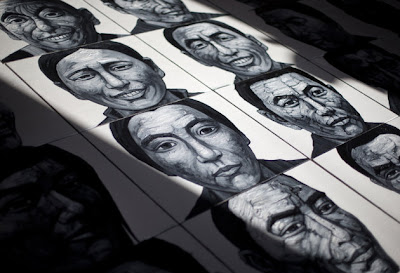 |
| 图片由美联社(AP)拍摄。 |
自由亚洲:藏区3年近百藏人自焚 汉族画家画肖像为生命立碑
2013-01-15
来自甘肃兰州的北京艺术家刘毅是一位关切藏人自焚事件的汉族画家,他从2012年春开始为境内自焚藏人画肖像,为这一波近现代史上最大的自焚抗议浪潮留下见证。他呼吁人们从人道主义的角度关切藏人自焚事件。
曾多次去过藏区的北京汉族画家刘毅(藏名:喜热布)从2012 年开始为自焚藏人画肖像,至今已画了近40幅。他的画均采用黑白色调,画中人表情各异,这些藏人为求自治而不惜自焚,让刘毅的心为之触动,于是,他选择用 画笔为自焚藏人立碑。 3年多来,藏区有近百藏人自焚,2013年的第一宗藏人自焚事件就来自刘毅的家乡甘肃省。
本台记者周二联系到了刘毅,他说“我是从2012年开春开始画的,实际上我从八十年代就一直画西藏题材。原来画《圣地拉萨》,还画过玉树地震题材。从 2009年2月第一个自焚藏人之后,当时我心里就特别(难受),但没想到后来规模这么大,后来也就很自然地画这个题材了。我想的就是说,记录吧,作为画家 我就想用我自己的方式来表达。”
2012年共有85位藏人自焚,对此中共在藏区採取了一系列的高压维稳政策,自焚者的亲属、好友及有关人士均受到株连,有的被抓捕判刑。中国外交部发言人 洪磊称:“ 藏区发生的一些藏人自焚的事件,据我们的掌握,大部分跟达赖集团的煽动有关。”中国当局认为,这是达赖集团分裂中国的行为。
对此,刘毅有不同的看法,他认为,藏人自焚的原因是宗教上的创伤。他说:“实际上藏区我去过很多地方,我觉得还是宗教上心灵上的创伤。我觉得达赖喇嘛说的 那句话特别好,西藏问题就是个道德问题,是文明和野蛮的一种较量。我现在画了40幅,我想还得继续画,我真希望再没有自焚了。”
去年国际人权日当天,刘毅将自焚藏人画像发在新浪微博上,结果他的微博迅速被关闭。 他说:“12月10日那天是人权日,没想到那天我放了12张上去,结果整个号就被封掉了。我又开了一个号,但再没有放画像。”
当局采取全方位的封锁措施,试图消声自焚事件。刘毅用翻墙软件得到消息,然后从唯色的博客里找到自焚藏人的照片,为他们画肖像。
他说:“事实上这个事是很沉重的,我希望更多人能了解真实的情况。比如说在我身边几乎大家都不谈这个事。在国内,关于自焚的事,从新闻上根本看不着,我基本都是从网上得知的,包括自由亚洲和法广。”
在作画的过程中,刘毅的内心十分煎熬,所有的画都是采用黑白的色调,以此传达出心中的沉重,支持他画下去的动力就是对生命的关注,他希望社会不要从意识形态、或者是国家或民族的角度去看待藏人自焚事件,而是关注人本身和生命。
他说:“画的过程中心里特别压抑,他们实际上是为了人的尊严而自焚。西藏和内地不一样,他更多地注重精神,不像内地更追求物质。西藏精神更多地体现了信 仰。我画的全是用黑白的,从色彩上表达沉重。你想一个人能把自己点燃,你看人类历史,再没有比这更大的事件了。超出正常情况了。”
藏族女作家唯色的博客,“看不见的西藏”上传了刘毅的画作,有匿名网友留言称:“能理解画家内心的哀伤、悲痛和无力感。向画家致敬。谢谢他,也谢谢你。”
(以上是自由亚洲电台特约记者忻霖的采访报道。http://www.rfa.org/mandarin/yataibaodao/tibet-01152013105545.html)
 |
| 图片由美联社(AP)拍摄。 |
Chinese painter portrays Tibet self-immolators
By | Associated Press – Sat, Jan 12, 2013
BEIJING (AP) — Beijing-based artist Liu Yi is
working on a series of black-and-white portraits he knows will never be
shown in a Chinese gallery. His varied subjects — men and women, young
and old, smiling and pensive — have one thing in common: They areTibetans who have set themselves on fire to protest repressive Chinese rule.
Liu wants to paint a portrait of each of the hundred-or-so Tibetans who
have self-immolated over the past three years, as a way of bearing
witness to one of the biggest waves of fiery protests in recent history.
With each brushstroke, Liu is making a heartfelt plea: The burning must
end.
"When I'm painting, I'm thinking: 'Enough, enough, don't do this
anymore. Stop,'" said the soft-spoken artist who has completed 40 so
far. "That's enough."
Liu is rare among his contemporaries for addressing the largely taboo
topic. Only a tiny handful of activists from the Han Chinese majority
have spoken out, among them the prominent legal scholar Xu Zhiyong.
At the heart of the silence is Han Chinese indifference or even
hostility to the Tibetan cause, despite some overlap with liberal Han
activists who chafe at authoritarian controls. "We are victims
ourselves," Xu wrote in a recent op-ed piece in which he apologized for
the silence.
Many among the majority see the immolations as part of attempts to break away from China and
wonder why Tibetans aren't more grateful for government development of
their region with rail links, expressways, houses and factories.
Han Chinese also tend to see Tibet,
with its breathtaking mountain grasslands and yak-rearing nomads, as a
wild and unknowable region — but one that fascinates nonetheless.
Year-round, Chinese tourists stream into a famous Tibetan Buddhist
temple in Beijing to offer incense before snapping up cheap Tibetan jewelry or artifacts in the city's many stores.
Although Han Chinese activists increasingly advocate the preservation of
Tibet's pristine environment, most draw the line at political issues,
staying mum as Tibetans drink gasoline and douse themselves with it
before lighting themselves in calls for religious freedom and autonomy.
Liu hopes to change that.
"I also hope that everyone won't look at it in an ideological or ethnic
way, but to pay attention to it from a humanitarian perspective," he
said.
Liu chose to paint close-ups of his subject's faces, offering an
intimate impression of their every wrinkle, crease, frown or smile,
using thick brushstrokes in stark black and white. Many of the subjects
are gazing straight at the viewer, creating an arresting effect,
especially when the portraits are arranged as a single, large montage.
"You can see that many of them are very young," Liu said as he showed
Associated Press reporters his paintings in a recent interview. The
works were laid out on the floor of his studio in five rows of eight
portraits each. He pointed at two boyish-looking faces in the bottom row
and said: "This one is 15, that one is 16."
Tibetan poet and activist Woeser says the self-immolations "express a form of misery and are an outright protest."
"A lot of Han intellectuals are not willing to accept political
demands," Woeser, who goes by one name, said in an interview. "In their
consciousness, Tibet is a part of China. They think, 'If you have
political demands, maybe what you want is independence, and so on.'"
Tibetan activists say the protests stem from frustration over China's
stifling security presence, restrictions on religion and the
demonization of their beloved spiritual leader, the Dalai Lama. China
has said the Dalai Lama instigates the self-immolations to undermine
Beijing's economic assistance to the region.
The number of protests spiked in November as China's Communist Party held a conclave to install its next generation of leaders.
"At this challenging time, not only do we need the international
community's attention but also that of the Chinese society," Woeser
said. "It is very important that Han intellectuals say something and
make clear expressions about this problem."
At a deeper level, she said, many Han feel alienated from the Tibetan way of life and its spiritual philosophy.
"Tibetan and Han culture differs in that one is spiritual and the other
is material. This difference is actually a gulf, it's hard to bridge,"
she said. "A lot of Han people cannot believe how Tibetans would do
things out of a spiritual desire, including setting themselves on fire."
Among Hans who have taken up the cause are Beijing-based rights advocates Hu Jia and Liu Shasha, who have posted Twitter messages about the immolations, urging an end to repressive policies.
Xu, the legal scholar, went a significantly riskier step further,
attempting to visit the family of a self-immolator named Nangdrol in
tightly controlled Aba prefecture in October.
"I am sorry we Han Chinese have been silent as Nangdrol and his fellow
Tibetans are dying for freedom," Xu wrote in the op-ed piece published
by The New York Times last month. "We are victims ourselves, living in
estrangement, infighting, hatred and destruction. We share this land.
It's our shared home, our shared responsibility, our shared dream — and
it will be our shared deliverance."
For the artist Liu, who is half Han, half Manchu and a follower of
Tibetan Buddhism, there is a personal and spiritual element to his
project.
"When I'm painting them, I always feel that I am receiving blessings. I
become gentler, kinder," Liu said of the portraits. "These people are
not attacking other people, they are completely sacrificing themselves."
 |
| 图片由美联社(AP)拍摄。 |
延伸阅读:
画家刘毅用画笔为自焚藏人立碑(一)http://woeser.middle-way.net/2012/12/blog-post_23.html
画家刘毅用画笔为自焚藏人立碑(二)http://woeser.middle-way.net/2012/12/blog-post_25.html





沒有留言:
張貼留言